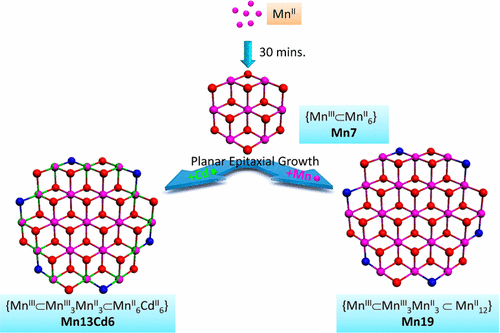当前位置:
X-MOL 学术
›
J. Am. Chem. Soc.
›
论文详情
Our official English website, www.x-mol.net, welcomes your
feedback! (Note: you will need to create a separate account there.)
Core–Shell {Mn7⊂(Mn,Cd)12} Assembled from Core {Mn7} Disc
Journal of the American Chemical Society ( IF 14.4 ) Pub Date : 2017-09-21 00:00:00 , DOI: 10.1021/jacs.7b08679 Ling-Yu Guo 1 , Hai-Feng Su 2 , Mohamedally Kurmoo 3 , Chen-Ho Tung 1 , Di Sun 1, 2 , Lan-Sun Zheng 2
Journal of the American Chemical Society ( IF 14.4 ) Pub Date : 2017-09-21 00:00:00 , DOI: 10.1021/jacs.7b08679 Ling-Yu Guo 1 , Hai-Feng Su 2 , Mohamedally Kurmoo 3 , Chen-Ho Tung 1 , Di Sun 1, 2 , Lan-Sun Zheng 2
Affiliation

|
Postsynthetic decoration of the Mn7, {MnIII⊂MnII6}, core with CdII in the outer shell to form the next generation Mn13Cd6, {MnIII⊂MnIII3MnII3⊂ MnII6CdII6}, core–shell disc was achieved and confirmed by single-crystal X-ray diffraction. The formation of Mn13Cd6 has only been successful with CdII and if the Cd salt is added within the first half hour window when the inner Mn7 has formed. EDX and ICP-AES gave the accurate content and confirm the average found by X-ray diffraction. HR-ESI-MS was even more precise by revealing three prominent molecular species, Mn13Cd6, Mn14Cd5 and Mn15Cd4, having a distribution of metals. The presence of nonmagnetic metal on the periphery reduces the exchange between these clusters as well as the low magnetic moment decreases the dipolar interaction resulting in a paramagnet compared to the ferrimagnetism found for the parent Mn19, {MnIII⊂MnIII3MnII3⊂MnII12}, disc. This study opens the way for the syntheses of heterometallic core–shell clusters in a controllable fashion.
中文翻译:

核-壳{锰7 ⊂(锰,镉)12 }从芯{锰组装7 }光盘
中的Mn的合成后装饰7,{锰III ⊂Mn II 6 },芯与镉II在该外壳以形成下一代的Mn 13镉6,{的Mn III ⊂Mn III 3的Mn II 3 ⊂锰II 6镉II 6 },获得了核-壳盘并通过单晶X射线衍射进行了证实。Mn 13 Cd 6的形成仅在Cd II上成功完成,并且如果在内部半Mn 7的前半小时窗口内添加了Cd盐,已经形成。EDX和ICP-AES给出了准确的含量,并通过X射线衍射确定了平均值。HR-ESI-MS通过揭示具有金属分布的三个重要分子物种Mn 13 Cd 6,Mn 14 Cd 5和Mn 15 Cd 4甚至更加精确。非磁性金属的周边上的存在降低这些簇之间的交换以及低磁矩减小导致顺磁体相比,亚铁磁性的偶极相互作用找到父的Mn 19,{的Mn III ⊂Mn III 3的Mn II 3 ⊂锰II 12},光盘。这项研究为以可控的方式合成异金属核-壳簇开辟了道路。
更新日期:2017-09-21
中文翻译:

核-壳{锰7 ⊂(锰,镉)12 }从芯{锰组装7 }光盘
中的Mn的合成后装饰7,{锰III ⊂Mn II 6 },芯与镉II在该外壳以形成下一代的Mn 13镉6,{的Mn III ⊂Mn III 3的Mn II 3 ⊂锰II 6镉II 6 },获得了核-壳盘并通过单晶X射线衍射进行了证实。Mn 13 Cd 6的形成仅在Cd II上成功完成,并且如果在内部半Mn 7的前半小时窗口内添加了Cd盐,已经形成。EDX和ICP-AES给出了准确的含量,并通过X射线衍射确定了平均值。HR-ESI-MS通过揭示具有金属分布的三个重要分子物种Mn 13 Cd 6,Mn 14 Cd 5和Mn 15 Cd 4甚至更加精确。非磁性金属的周边上的存在降低这些簇之间的交换以及低磁矩减小导致顺磁体相比,亚铁磁性的偶极相互作用找到父的Mn 19,{的Mn III ⊂Mn III 3的Mn II 3 ⊂锰II 12},光盘。这项研究为以可控的方式合成异金属核-壳簇开辟了道路。











































 京公网安备 11010802027423号
京公网安备 11010802027423号